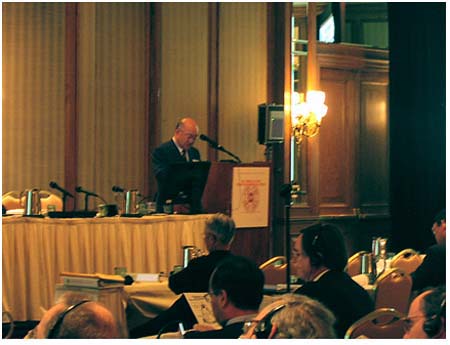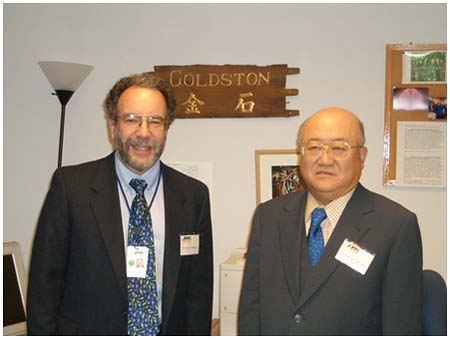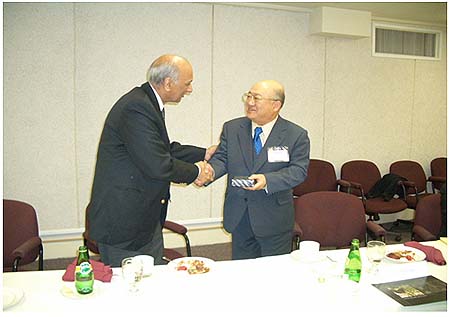President Tonozuka made a visit to U.S.A. from November 19th
to 26th,, 2005. He participated in the sixth "U.S. - Japan
Workshop on Nuclear Energy" and delivered a presentation
entitled "Development of Nuclear Energy R&D and U.S.
- Japan Collaboration in Japan Atomic Energy Agency". He
also made a courtesy visits to Princeton University Plasma Physics
Laboratory, as well as to Brookhaven National Laboratory during
which he introduced the establishment of JAEA and exchanged opinions
on the future research cooperation.
1. The sixth "U.S.-Japan workshop on Nuclear Energy
In this workshop, he explained the current situation of JAEA's research and development (R&D), regarding Monju-based fast reactor system and introduced a collaborative research plan on minor actinides combustion technology among Japan, U.S. and France.
He also introduced R&D of fusion and hydrogen production using the high temperature gas cooled reactor, concluding his presentation by informing on the progress in computational science, which could bring epoch-making innovation to nuclear developments.

JAEA President Tonozuka delivers presentation
2. Visit to Princeton University, Plasma Physics Laboratory (PPPL)
Chartered in 1746, Princeton University is North America's fourth-oldest
college, with the history of more than 250 years. Princeton is
also famous for Albert Einstein and Hideki Yukawa, and about 30
Nobel Prize winners, including 20 Physics Prize awardees. Princeton
University Plasma Physics Laboratory (PPPL) has conducted cooperative
research on large Tokamaks with former JAERI under "Implementing
Agreement on Cooperation among the three large Tokamak facilities
(JET, JT-60 and TFTR)". In cooperation since 1986, former
JAERI and PPPL are actively engaged in many research experiments
through staff exchanges and remote participation in JT-60 from
the US. During his courtesy visit to PPPL, Tonozuka held a meeting
with Dr. Goldstone, PPPL Director, and Dr. Hawryluk, Deputy Director,
Dr. Sauthoff, ITER Project Manager and Dr Ono, NSTX Director.
Dr. Goldstone was very pleased that "PPPL and JAERI have
engaged in many collaborative researches so far and these efforts
of both competition and cooperation have contributed to a stronger
relationship." He also extended his appreciation for Mr.
Tonozuka's prompt consideration of paying a courtesy call to PPPL,
immediately after the JAERI/JNC integration.

Courtesy visit to Dr. Goldstone, PPPL Director at Princeton University
President Tonozuka remarked, "For the development of future
sources of energy, a global strategy is necessary and JAEA, as
an international organization, is working toward the formulation
of a long term energy supply strategy with a viewpoint of international
cooperation. As for nuclear fusion, US-Japan cooperation has played
an important role in making major advances. I appreciate your
cooperation and I will continue to foster global cooperation in
development."
3. Visiting Brookhaven National Laboratory (BNL)
Brookhaven National Laboratory was established on March 21, 1947
under the U.S. Atomic Energy Commission (AEC), the federal agency
later reorganized to the present U.S. Department of Energy (DOE)
with the aim to promote a peaceful use of nuclear power to improve
the welfare of US citizens. Today BNL is operated with a mission
to train excellent scientists and develop advanced technology.
During the half century since BNL's establishment, six Nobel Prizes
have been awarded for their discoveries. BNL consists 13 research
department and divisions: Biology, Center for Functional Nanomaterials,
Chemistry, Collider-Accelerator, Energy Sciences & Technology,
Environmental Sciences, Condensed Matter Physics & Materials
Science, Medical, National Synchrotron Light Source, Nonproliferation
& National Security, Physics, Instrumentation Division, and
Superconducting Magnet Division.
As for cooperation of BNL and JAEA, collaboration with former
JAERI has been actively carried out on nuclear data R&D since
1989. In 1998, the experimental result of proton beam injection
to a mercury target helped to improve the design and production
of the nuclear spallation neutron source of J-PARC. In the field
of photoradiation, research cooperation in the resonance scattering
experiment that takes advantage of soft X-rays source is carried
out using the advanced photoradiation experimental facility of
BNL. In the field of light water reactors, two R&D cooperations
have started under a framework agreement with DOE since 2004.
One concerns the reactor core design technique of a thermal light
water reactor, and the other concerns cooperation about decommissioning
technology.

Courtesy visit to Mr. Chaudhari, Director of Brookhaven National
Laboratory
President Tonozuka met with Dr. Chaudhari, BNL Director, Dr.
Bond, Deputy Director for Science & Technology, Dr. Aronson,
Associated Laboratory Director for High Energy and Nuclear Physics,
Dr. Lowenstein, Chairman of the Collider-Accelerator Department,
and Dr. Chao, Associate Chairman for the User Science Division.
Director Chaudhari commented, "We have maintained research
cooperation in the many fields with the former JAERI. I would
like to have additional research cooperation from now".
President Tonozuka commented, "Since JAEA is also carrying
out broad research and development, from Fast Reactor cycle technology
to radiation use for the public, I was really interested in the
wide-range of research activities at BNL. I recognize that the
cooperation for target development on the J-PARC project represented
an especially beneficial partnership between BNL and JAERI. We
now expect further participation in the J-PARC project from BNL."
The BNL side commented in response "Since our scientists
jointly combine to the best institution in the world, R&D
partnership would be extended more and more from now".
4. Conclusion
The impressions that are gained by attending "US-Japan workshop
on Nuclear Energy" and visiting two research institutions
are summarized as follows;
- While international cooperation becomes diversified and multi-centered,
it is important to formulate comprehensive and frontier strategies
with a higher and broader view, which includes the relations with
France, Asian countries, and so on in the context of good US-Japan
relations.
- Finally, I have come to recognize that, upon the establishment
of the Japan Atomic Energy Agency, both of these state-of-the-art
laboratories in the United States are expecting greatly for the
abilities in our research and development. I have come to reaffirm
our determination for JAEA to continue to advance research and
development for peaceful use of nuclear power for Japan and the
rest of the world for the future.






